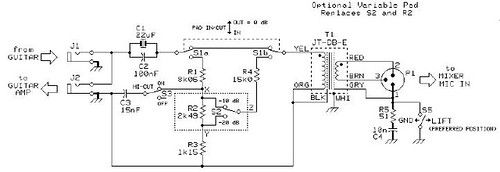Hi
I am looking at trying a build of the Chycki tube DI’s but whilst looking through the article here…
http://twin-x.com/groupdiy/albums/userpics/Buffered_Tube_DI_r.jpg
http://twin-x.com/groupdiy/albums/userpics/Buffered_Tube_DI_2_r.jpg
I am a little concerned about the grounding considering it has a built in mains power supply. The text reads…
Is there any way around this as I would rather have a permanent earth bond to the case for safety. Could the circuit 0V be isolated from the chassis by using insulated jacks and then only connected via the earth lift switch or similar or will this result in noise?
What is the consensus here on the board on the correct way to handle this?
Cheers
Ray
I am looking at trying a build of the Chycki tube DI’s but whilst looking through the article here…
http://twin-x.com/groupdiy/albums/userpics/Buffered_Tube_DI_r.jpg
http://twin-x.com/groupdiy/albums/userpics/Buffered_Tube_DI_2_r.jpg
I am a little concerned about the grounding considering it has a built in mains power supply. The text reads…
There is no wall ground connected to the DI because any differential current between the box and components could induce hum by capacitance. The shield of either the input or balanced cable provides suitable protection and since the unit is never used without both cables intact, everything stays nice and safe.
Is there any way around this as I would rather have a permanent earth bond to the case for safety. Could the circuit 0V be isolated from the chassis by using insulated jacks and then only connected via the earth lift switch or similar or will this result in noise?
What is the consensus here on the board on the correct way to handle this?
Cheers
Ray



